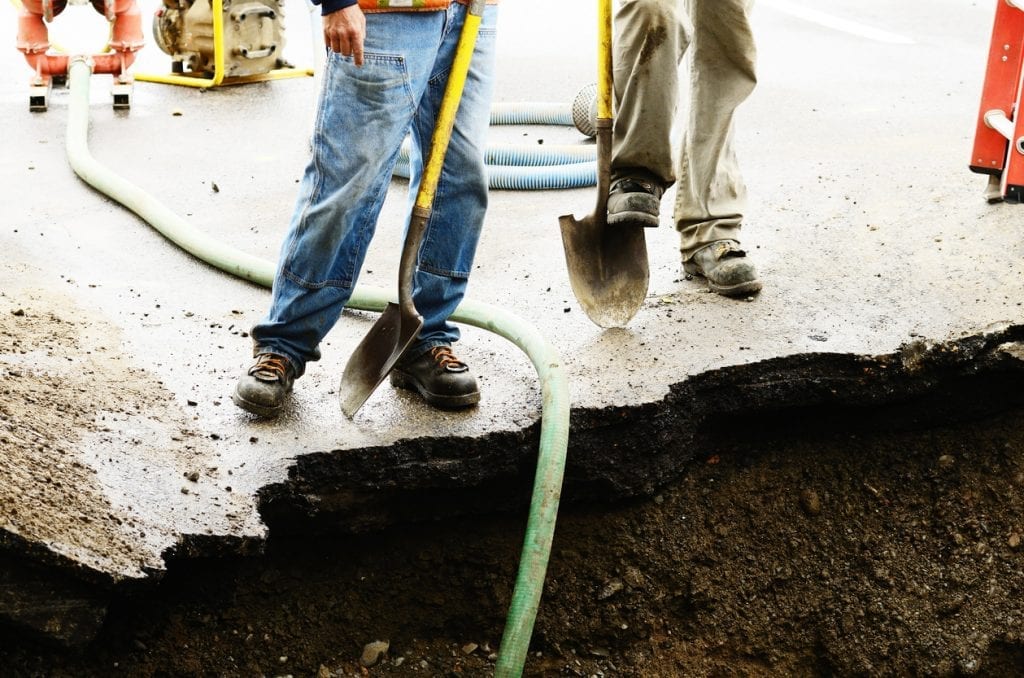It’s a word that evokes childhood nightmares of quicksand and disappearing into the void. The word is “sinkhole” and, unfortunately, it’s not only the stuff of nightmares but a real possibility for millions of Floridians.
More than most parts of the U.S., Florida is susceptible to sinkholes because of the geology of the peninsula. Under Florida’s verdant landscape lies various mixtures of sand and clay, and under that, a base of carbonate rock, mostly limestone and dolostone. These carbonate rocks have the unfortunate quality of dissolving gradually via a slow chemical process, which results in terrain known as karst.
Sinkholes are what happens when the materials over the karst subside or collapse into voids formed by dissolving rocks. When this happens under a building, the result is either a slow destabilizing of the structure or a sudden collapse.
In either case, it’s bad news for the property owner and the insurance company. Here’s what you need to know.
Why We’re Seeing More Sinkholes Than Ever
If you watch the news or pay attention to social media in Florida, it’s inevitable that you have seen videos and heard stories about homes and businesses destroyed in an instant by sinkholes. Based on news coverage, it certainly seems like this is a growing problem.
The reality is more complex. It is unlikely that the underlying topography of our state has changed dramatically in a few decades. It’s much more likely that we’re seeing more sinkholes due to these three factors:
- Population growth
- Sinkhole insurance claims
- Triggering events
Population growth means that more people are building in sinkhole-prone areas, which means more buildings are damaged by sinkholes. It also means more people are recording the incidents. Add to that the fact that Florida mandated sinkhole coverage riders in 1981, which led to a rash of insurance claims.
And, finally, with more people and more activity in the state, we may be seeing more triggering events. Trigger events are any action, natural or human-caused, that precipitate the subsidence or collapse of a sinkhole. Some triggers are not directly impacted by human activity, such as hurricanes, or drought followed by heavy rainfall. Other triggers, however, can very much be impacted by human activity. For instance:
- Heavy pumping of groundwater for agricultural use
- Well drilling
- Excavation
- Overloading of sediments
- Blasting, pounding, and other heavy construction activities
Sinkholes Don’t Always Cause Immediate Collapse
Sudden collapse is always sensational and sometimes tragic, as in the 2013 case that killed a young man. However, more often sinkhole activity occurs gradually over time and leads to structural issues including:
- Cracked foundations
- Sinking foundations
- Unlevel floors
- Windows and doors not functioning properly
- Other structural issues
These problems can have causes other than sinkholes. In fact, sinkholes are far less common than many other causes of structural issues. If, however, the damage is caused by a sinkhole it’s important to know that before further damage or catastrophe strikes.
For that reason, we’re often called in by insurance adjusters to first do a structural evaluation, and, if warranted, do a sinkhole evaluation to determine the cause of structural damage.
How We Conduct Sinkhole Evaluations
Structural and sinkhole evaluation standards are set by the state of Florida, in FGS Special Publication 57 and Florida Statutes Chapter 627.706. At the same time, due to the unpredictability and hazards of sinkholes, much is left to the good judgment of the evaluating firm, which is why it’s important that your insurance company rely on experienced professionals like GLE.
Sinkhole investigation starts with visual inspection and measurements to determine the extent of structural damage, including any cracks, and whether the structure is plumb and level. Borings along the foundation can help determine both how deep the foundation goes and what the subsurface materials are. This can give us an idea whether sinkhole activity is likely in the area. We also look for other potential causes, that might rule out sinkhole activity.
If we have reason to suspect sinkhole activity, then we may employ ground penetrating radar (GPR) to determine what type of materials lie below the surface. This can sometimes give us enough information to determine the presence or absence of a sinkhole, but GPR is often limited by the fact that GPR does not penetrate water due to signal attenuation. For that reason, GPR only gives us information down to the depth of the groundwater table.
After that, if sinkholes are suspected and structural damage is present, we may bring in a drill rig to perform soil density sampling with depth around the house to a depth of structurally competent soil or rock. This will generally yield conclusive results, which we can then share with the insurance company.
What Happens if a Sinkhole is Discovered?
The vast majority of the time, structural issues are caused by non-sinkhole issues. It can be a bad foundation, soft subsoil, the presence of garbage in the soil that creates an unstable surface, organic material, or any number of other factors. In the event that a sinkhole is discovered, however, remediation may be complex, extensive and potentially hazardous.
Of course, the exact tactics vary widely based on each case, but in general, it becomes necessary to identify the location and extent of all voids, and then to fill them in with solid material. This requires drilling holes into the substrate and then pumping the voids full of grout, which is a specific type of concrete. The activity may be hazardous because sinkholes are unpredictable, and it’s possible for the activity of remediation to actually trigger the sinkhole to activate and cause further damage.
The alternative, however, is even grimmer. Left unaddressed, sinkholes can be devastating to a property and to the families who live and work in them. If you suspect your property may be sitting over a sinkhole, don’t hesitate to contact your insurance company and ask that they hire a competent and skilled investigation firm like GLE.



